Comparison of Torrefaction and Hydrothermal Treatment as Pretreatment Technologies for Rice Husks
Abstract
1. Introduction
2. Materials and Methods
2.1. Experimental Equipment and Method of Torrefaction
2.2. Experimental Equipment and Hydrothermal Treatment Method
2.3. Evaluation of Transportation Cost Using a Resource Island Model
- The production cycle unit for biomass resources is one year.
- Biomass resources are evenly distributed in the same resource island, and differences in yield of the same crop due to different conditions are ignored.
- The differences in parameters between the biomass of different types are also ignored.
3. Results and Discussion
3.1. Torrefaction
3.2. Hydrothermal Treatment
- In the hydrothermal treatment of rice husks, the weight after air-drying was 2.58 g, and the residual mass rate was 58.6%.
- With hydrothermal treatment in a NaOH solution, the solid matter’s weight after air-drying was 2.29 g, and the residual mass rate was 53.3%, which is lower than the results for the rice husk hydrothermal treatment in water.
3.3. Analysis of Torrefaction and Hydrothermal Treatment by TG/DTA
3.4. The Resource Island Model
4. Conclusions
- The utilization of rice husks, which are abundant in Myanmar, shows great potential. Studies are being conducted regarding gasification power generation for local production and local consumption, but the utilization of rice husks has so far been limited given the problems concerning bulk density and ash.
- In the torrefaction experiments on rice husks, results that showed improvement in the low heat value of rice husks were obtained. Whereas the low heat value of raw rice husks was 14.84 MJ/ kg, the low heat value of torrefied rice husks with a mean reaction temperature of 234.4 °C was 1.6-fold higher, at 17.2 MJ/kg. The experiments also showed that increasing the reaction temperatures in the torrefaction process tended to result in an increase in the low heat value of rice husk products. However, the experiments also showed that with the rise in reaction temperature, there will be less solid residue, with increases in the ratios of mass loss and ash.
- Hydrothermal treatment experiments were conducted in a liquid flow reactor to reduce ash and improve its characteristics as fuel. With hydrothermal treatment, it is possible to obtain products with less ash content than the torrefied rice husks of the same mass residual rate. Specifically, compared to the 26.7% ash ratio of the torrefied rice husks, the ash ratios of the rice husks processed with either water or NaOH solution were 13.96% and 8.87%, respectively. It can therefore be said that the significant advantage of this treatment lies in its reduction of the ash content of rice husks, which are an agricultural biomass material with a high ash ratio. In terms of ash content alone, rice husks treated with a NaOH solution are more suitable for energy fuel use. However, there is a trade-off between the use of NaOH and the increased efficiency of ash treatment, as the use of sodium hydroxide will increase the cost. This will be an issue for further research and review. Silica is the main component of ash. At room temperature, it can be partially dissolved in a NaOH solution. The solubility increases with increasing temperature. The sodium silicate produced by the dissolution can be dissolved in water, which means that the alkaline solution can separate the raw material’s silica component. Therefore, a speculation could be made that a large amount of silica can be dissolved in the reaction solvent to reduce ash under NaOH-hydrothermal treatment conditions.
- The effects on the reduction of transportation costs was computed through the resource island model. When rice husks were the raw material, the transportation cost reduction ratios, assuming no compression, were 54.9% for the hydrothermal treatment and 43.6% for torrefaction when the mass residual rate was 60%. Meanwhile, the transportation cost reduction ratio in the case of compression was 90.8% for the hydrothermal treatment and 88.7% for torrefaction. Regarding pretreatment of rice husks, the results demonstrate that the transportation cost reduction effect of hydrothermal treatment is more significant.
Author Contributions
Funding
Acknowledgments
Conflicts of Interest
References
- Pandyaswargo, A.H.; Pang, D.; Ihara, I.; Onoda, H. Japan-Supported Biomass Energy Projects Technology Readiness and Distribution in the Emerging Southeast Asian Countries: Exercising the J-TRA Methodology and GIS. Int. J. Environ. Sci. Dev. 2020, 11, 1–8. [Google Scholar] [CrossRef][Green Version]
- Study on Rice Husk Power Generation System for Low-Carbon Communities in Ayeyarwady Region; Institute Fujita Corporation: Tokyo, Japan, 2015; pp. 11–16.
- World Bank East Asia and Pacific Economic Update 2012: Remaining Resilient. The World Bank, 19 December 2012, pp. 20–21. Available online: https://www.worldbank.org/en/news/feature/2012/12/19/east-asia-and-pacific-economic-update-december-2012-remaining-resilient (accessed on 16 June 2020).
- Feasibility Study on Rice Husk Power Generation System for Low-Carbon Communities in Ayeyarwady Region, Myanmar; Mitsubishi Research Institute, Fujita Corporation: Tokyo, Japan, 2015.
- Sano, H.; Honjo, T. Principle of Semi-carbonization of Biomass and the Effect on Use. J. High Temp. Soc. 2011, 37, 43–49. [Google Scholar] [CrossRef]
- European Biofuels. Bioenergy Value Chains4: Pyrolysis and Torrefaction. 2016. Available online: http://www.etipbioenergy.eu/images/EIBI-4-torrefaction%20and%20pyrolysis.pdf (accessed on 7 September 2020).
- Cremers, M.; Koppejan, J.; Middelkamp, J.; Witkamp, J.; Sokhansanj, S.; Melin, S.; Madrali, S. Status Overview of Torrefaction Technologies: A Review of the Commercialisation Status of Biomass Torrefaction Executive Summary; IEA Bioenergy: Paris, France, 2015. [Google Scholar]
- Poudel, J.; Karki, S.; Oh, S.C. Valorization of Waste Wood as a Solid Fuel by Torrefaction. Energies 2018, 11, 1641. [Google Scholar] [CrossRef]
- Omura, K.; Pandyaswargo, A.H.; Hiroshi, O. LCCO2 of coal co-firing with imported torrefied woody biomass in Japan. J. E3S Web Conf. 2018, 74, 03001. [Google Scholar] [CrossRef]
- Tekin, K.; Karagoz, S.; Bektaş, S. A review of hydrothermal biomass processing. Renew. Sustain. Energy Rev. 2014, 40, 673–687. [Google Scholar] [CrossRef]
- Saha, N.; Saba, A.; Saha, P.; McGaughy, K.; Franqui-Villanueva, D.; Orts, W.J.; Hart-Cooper, W.M.; Reza, M.T. Hydrothermal Carbonization of Various Paper Mill Sludges: An Observation of Solid Fuel Properties. Energies 2019, 12, 858. [Google Scholar] [CrossRef]
- Available online: https://qgis.org/ja/site/ (accessed on 16 June 2020).
- Myanmar: Capitalizing on Rice Export Opportunities. The World Bank, 28 February 2014, pp. 53–54; Economic and Sector Work Report No. 85804. Available online: https://www.worldbank.org/en/country/myanmar/publication/myanmar-capitalizing-on-rice-export-opportunities (accessed on 16 June 2020).
- Aung, S.M. Burma—Union of Grain and Feed Annual, 2018 Annual Report; USDA Foreign Agricultural Service: Washington, DC, USA, 2018.
- Agriculture Guide 2019; EuroCham Myanmar: Yangon, Myanmar, 2018.
- Mofijur, M.; Mahlia, T.M.I.; Logeswaran, J.; Anwar, M.; Silitonga, A.; Rahman, S.A.; Shamsuddin, A.H. Potential of Rice Industry Biomass as a Renewable Energy Source. Energies 2019, 12, 4116. [Google Scholar] [CrossRef]
- Ogawa, G.; Wu, S.; Pandyaswargo, A.H.; Onoda, H. Experimental Study on Rice Husks Torrefaction: Technology Development Potential in Myanmar’s Unelectrified Area. In Proceedings of the International Workshop on Environmental Engineering 2019, Okinawa, Japan, 25–28 June 2019; E209. p. 6. [Google Scholar]
- Wu, S.; Cheng, T.; Onoda, H. Study on Applicability of Pretreatment Technology for Low-Grade Biomass Focusing on Hydrothermal Treatment and Torrefaction. In Proceedings of the Symposium on Environmental Engineering 2020, Turin, Italy, 29 June–2 July 2020; p. 208. [Google Scholar]
- Xing, A.; Liu, G.; Wang, Y.; Wei, F.; Jin, Y. Economic, Energy and Environment Analysis on Biomass Collection Process. Chin. J. Process Eng. 2008, 8, 305–313. [Google Scholar]
- Tan, Q.; Yang, H.; Zhang, X.; Deng, Y.; Wei, Y. Estimation Model and Empirical Analysis of Biomass Power Generation Fuel Collection Cost. Available online: www.china-nengyuan.com (accessed on 11 July 2017).
- Siddique, A.; Cachim, P. Waste and Supplementary Cementitious Materials in Concrete, Characterisation, Properties and Applications; Woodhead Publishing Series in Civil and Structural Engineering; Woodhead Publishing: Sawston, UK, 2018; pp. 417–460. [Google Scholar]
- Hu, J.; Du, Z.; Min, E. Progress in Research of Reaction Mechanism Concerning Hydro Thermal Liquefaction of Biomass; 100083; Research Institute of Petroleum Processing, SINOPEC: Beijing, China, 2012. [Google Scholar]
- Ruksathamcharoen, S.; Ajiwibowo, M.W.; Chuenyam, T.; Surjosatyo, A.; Yoshikawa, K. Effect of Hydrothermal Treatment on Grindability and Fuel Characteristics of Empty Fruit Bunch Derived Hydrochar. Int. J. Technol. 2018, 9, 1246–1255. [Google Scholar] [CrossRef]
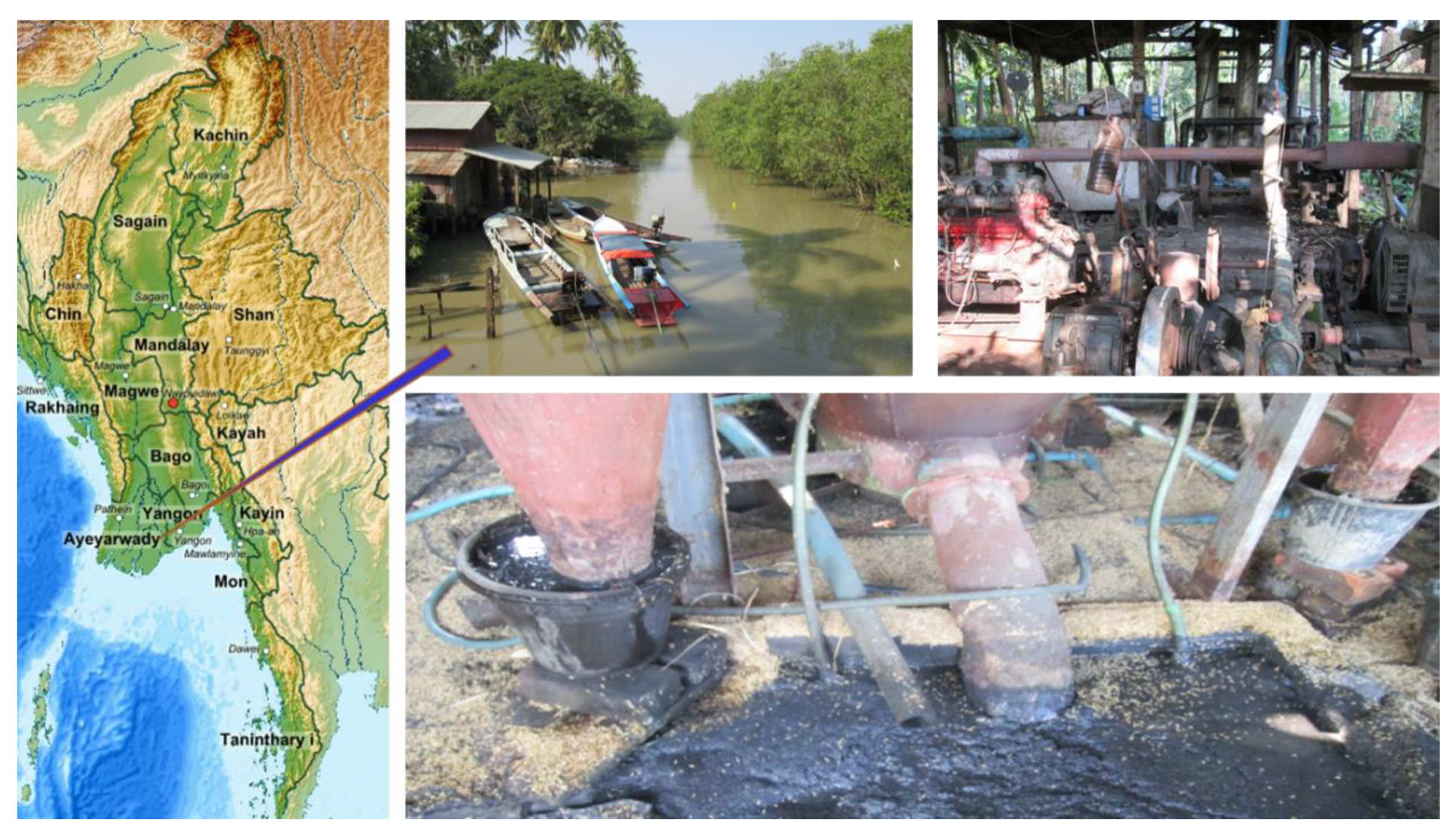


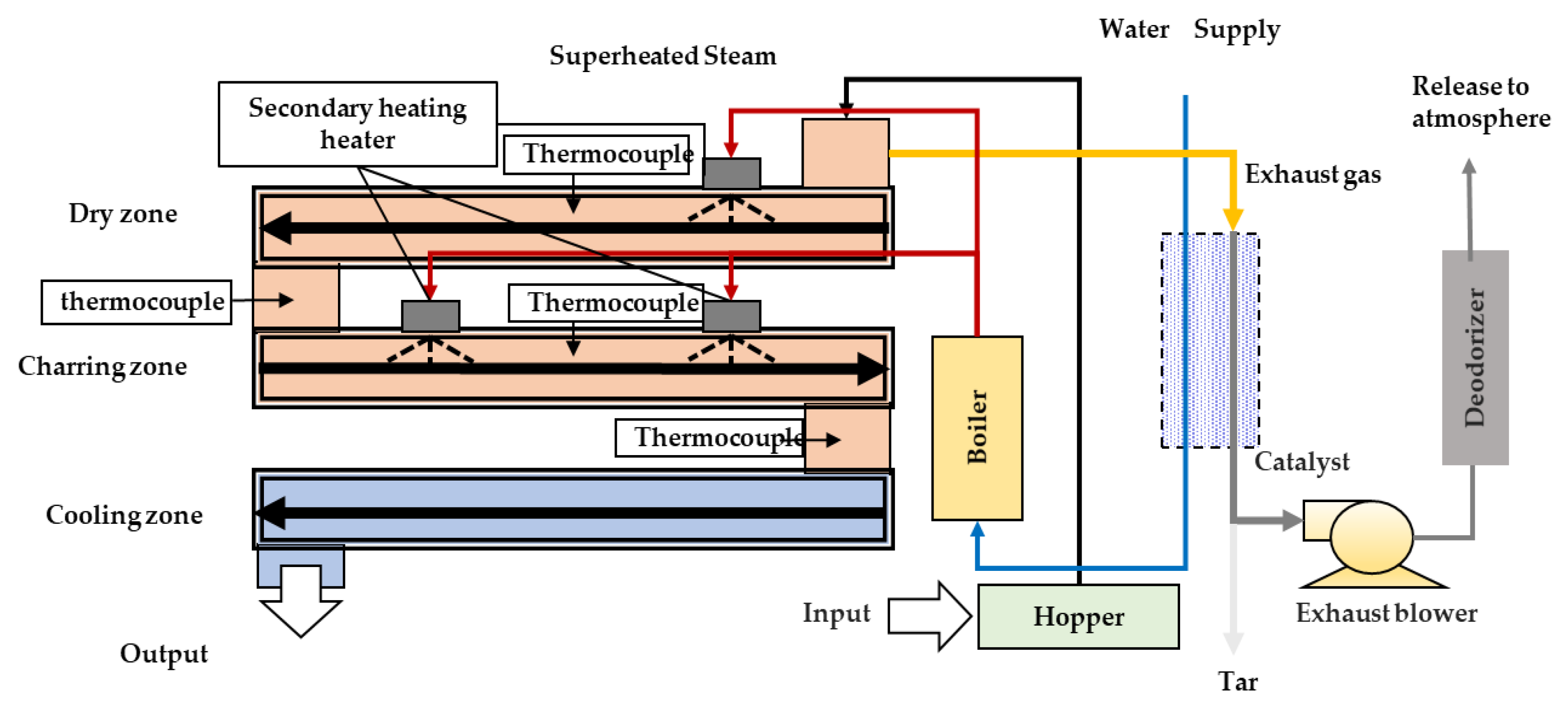

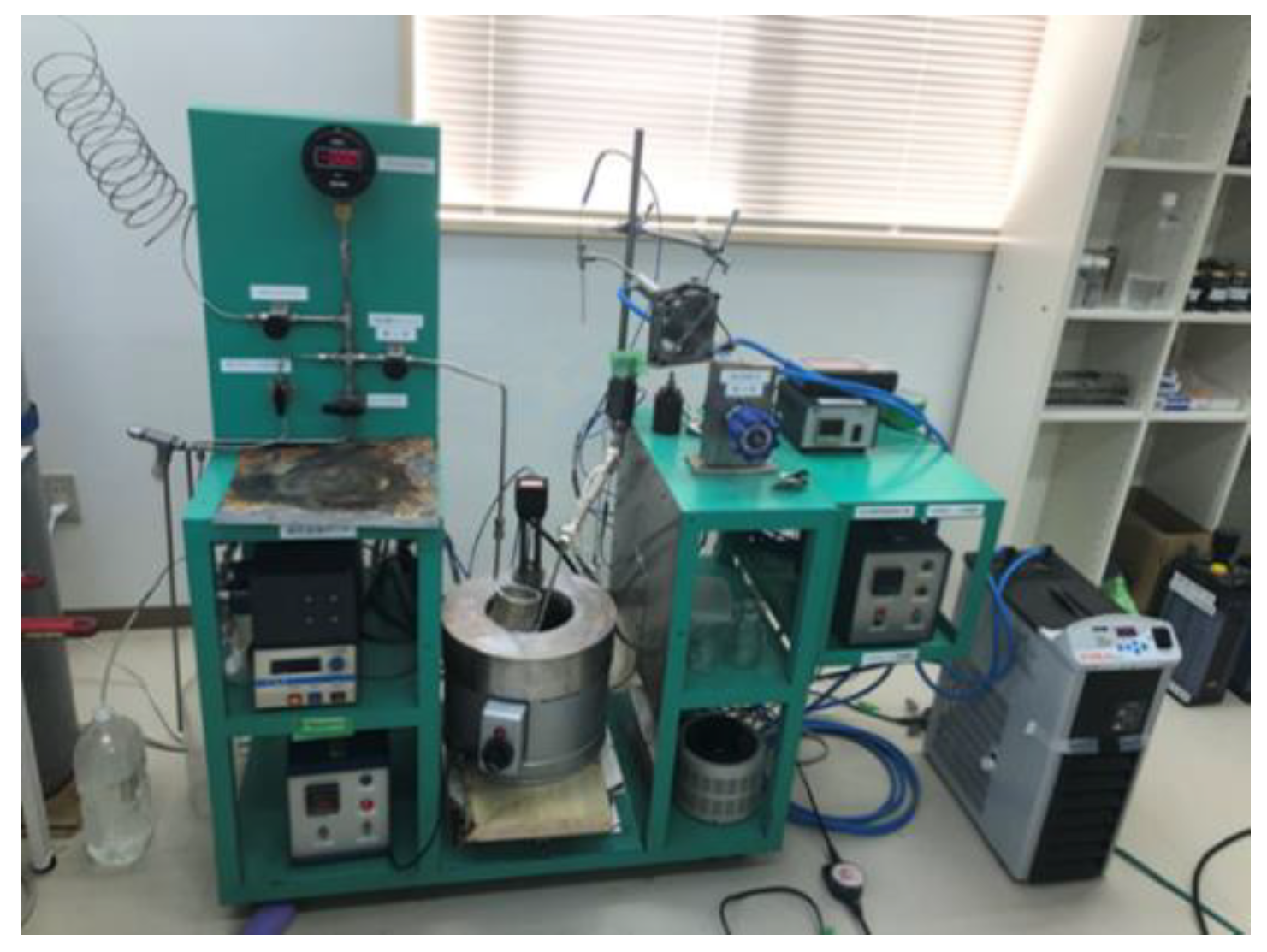
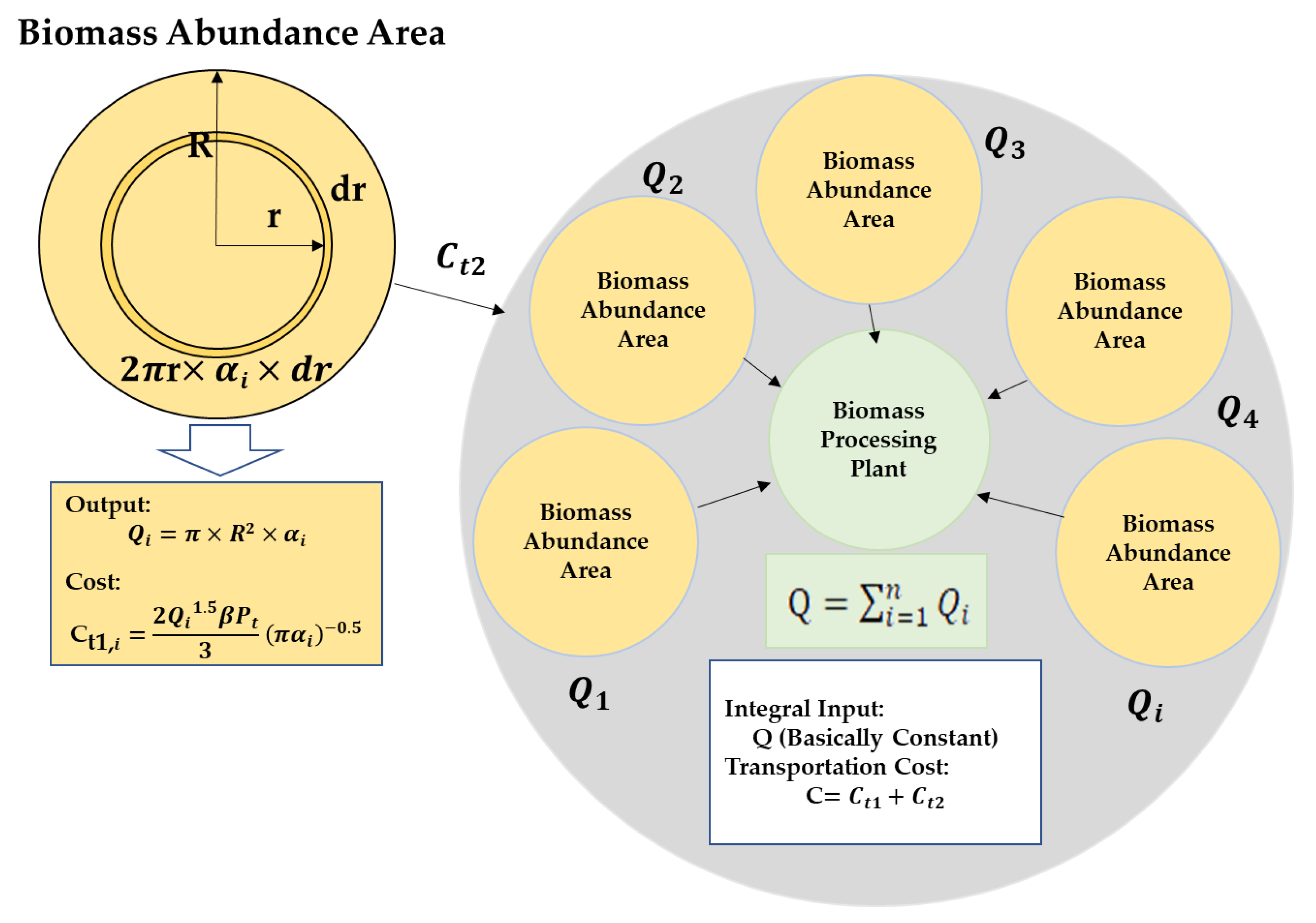
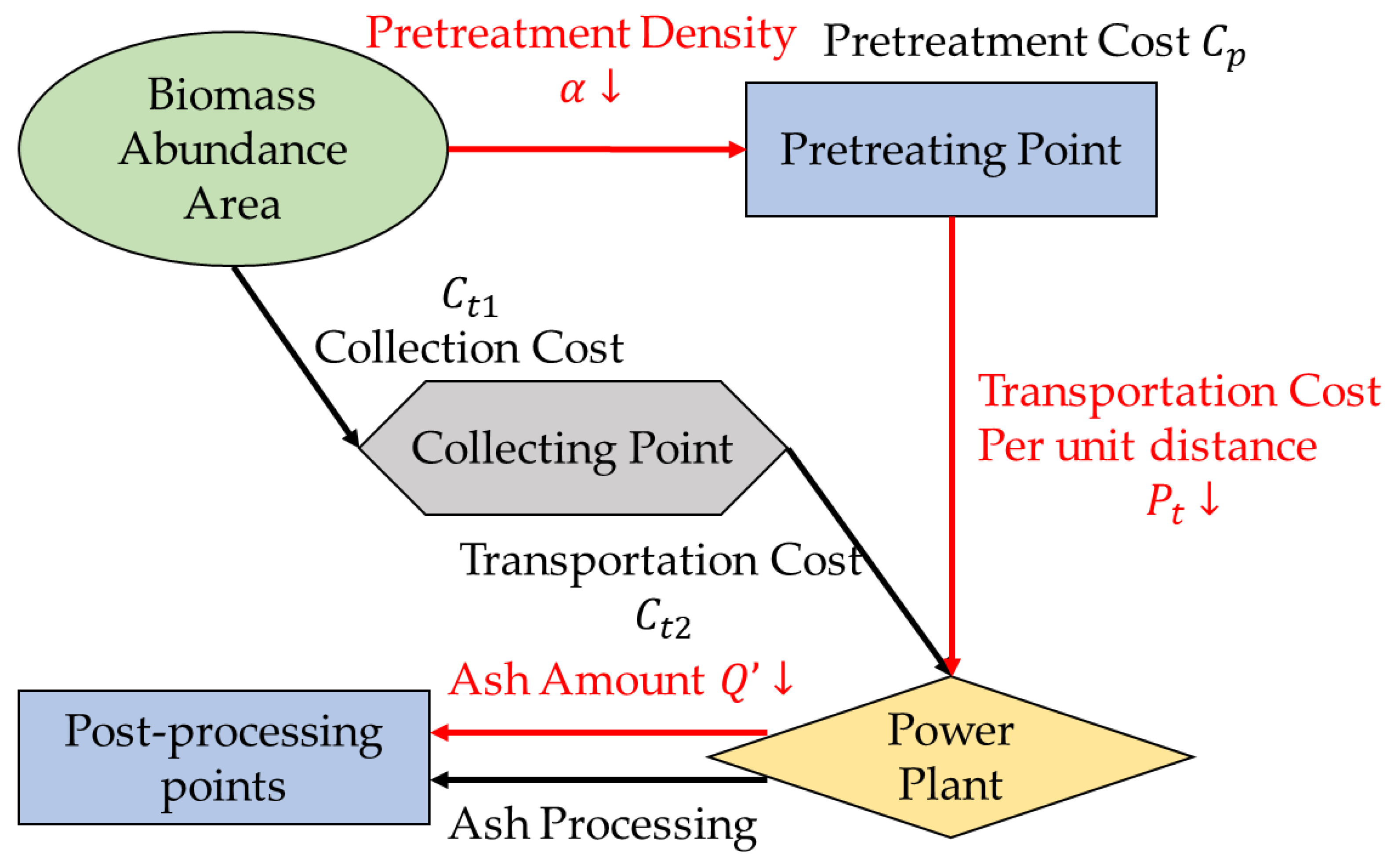



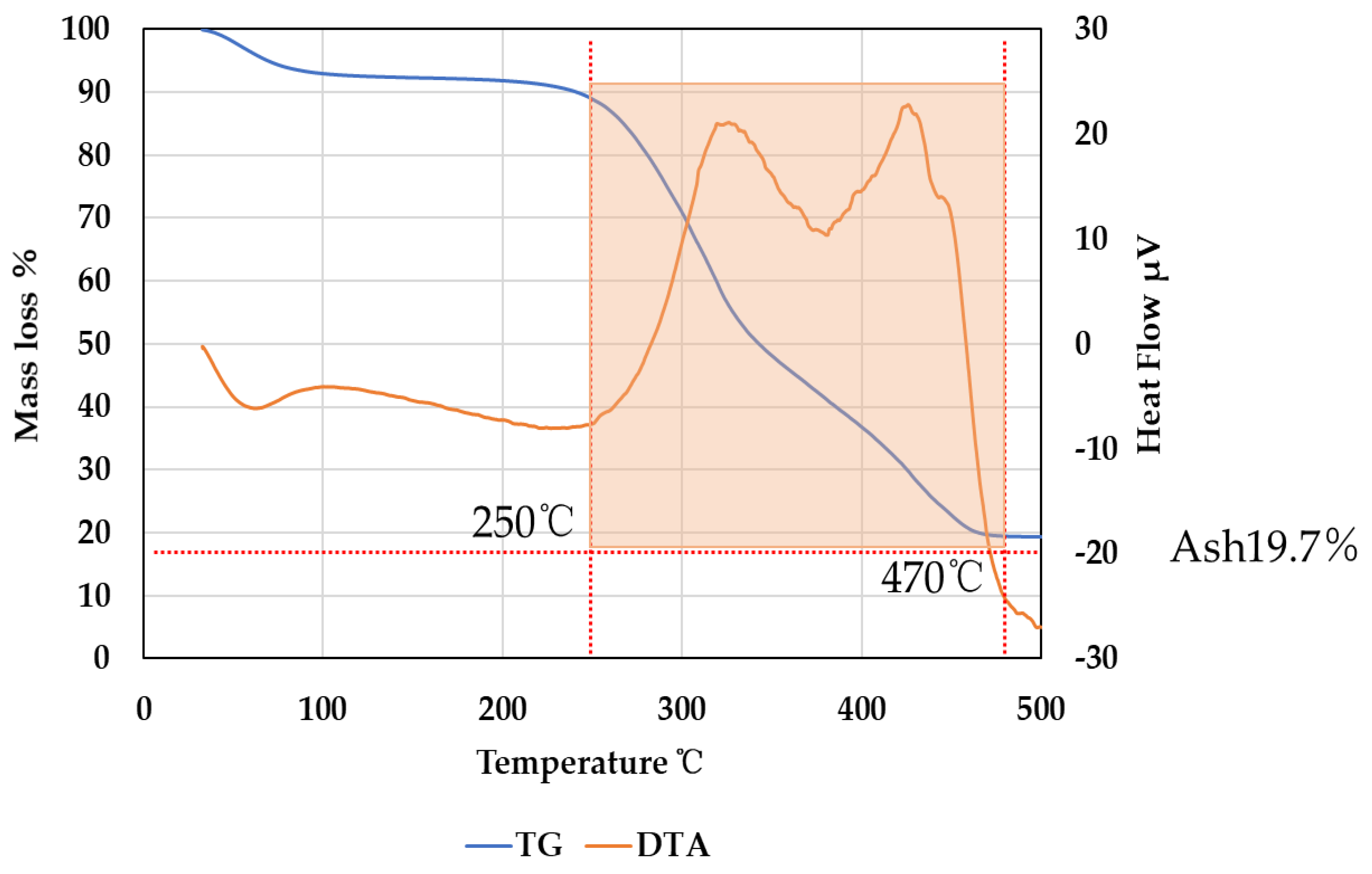



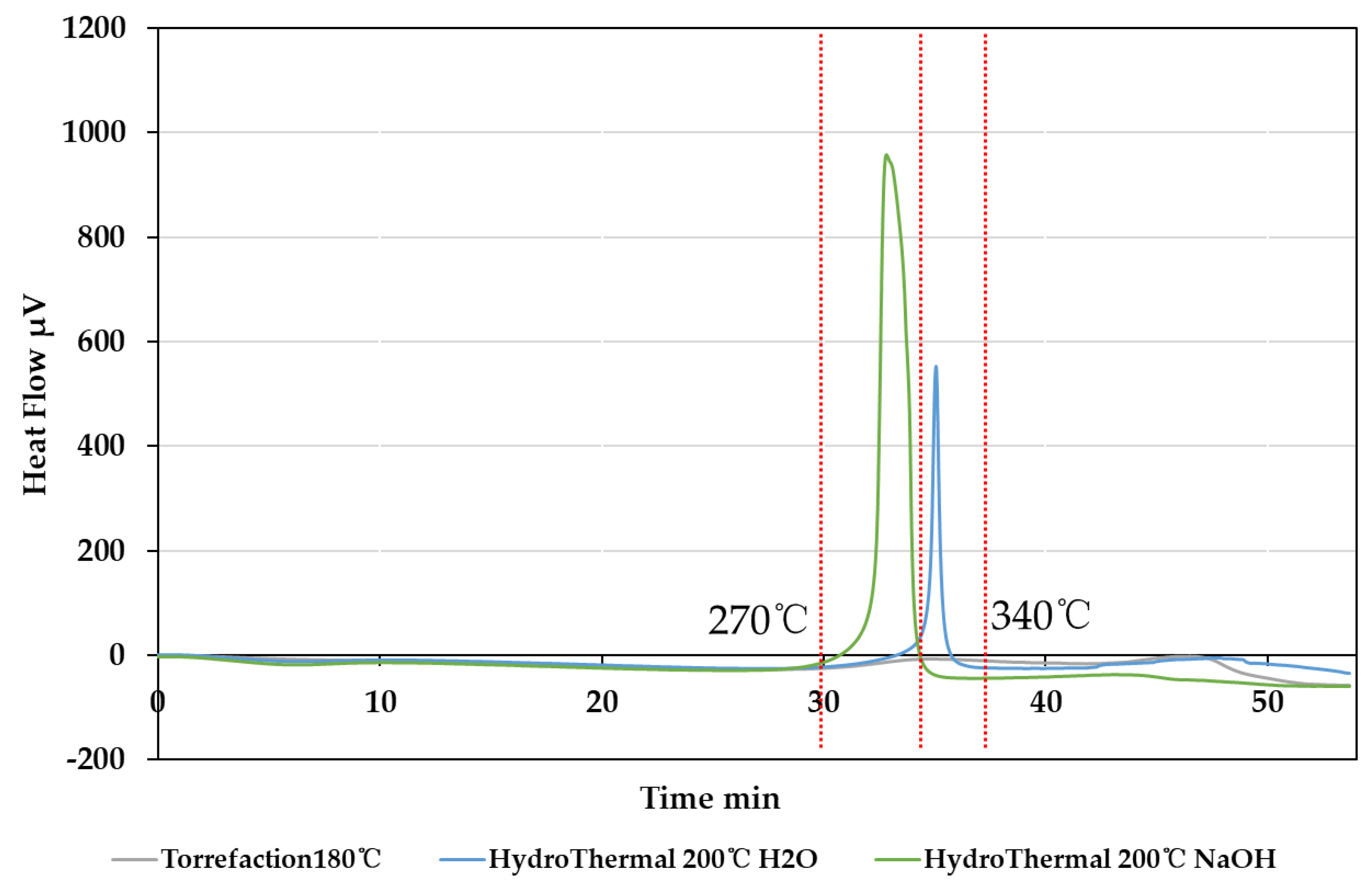

| Item | Processing Power | Power Consumption | Weight | Power Supply | Size | Electric Heater | Mode |
|---|---|---|---|---|---|---|---|
| Unit | kg/h | kW/h | t | V | mm | °C | - |
| Value | 50 | 15 | 2 | Three-phase 200 | D400 × W100 × H1900 | 300–600 | Superheated steaming |
| Item | Unit | Experiment 1 | Experiment 2 | Experiment 3 |
|---|---|---|---|---|
| Set temperature | °C | 250 | 180 | 150 |
| Experiment time | min | 45 | 45 | 45 |
| Input speed | g/min | 50 | 50 | 50 |
| Input | g | 454.6 | 454.6 | 454.6 |
| Water content | % | 8.3 | 8.3 | 8.9 |
| Dry zone | °C | 224.2 | 156.3 | 136.1 |
| Charring zone | °C | 234.4 | 176.3 | 140.1 |
| Weight | g | 232.1 | 283.0 | 396.3 |
| Mass Residue Rate | % | 51.07 | 62.26 | 87.18 |
| Project | Unit | Raw Rice Husks | Torrefied Rice Husks | ||
|---|---|---|---|---|---|
| 234.4 °C | 176.3 °C | 140.1 °C | |||
| Water content | % | 9.09 | 7.15 | 5.67 | 5.65 |
| Ash | % | 19.7 | 39 | 26.7 | 22.5 |
| Volatile | % | 63.5 | 19.3 | 48.5 | 57.6 |
| Fixed carbon | % | 16.8 | 41.7 | 24.8 | 19.9 |
| HHV | MJ/kg | 15.94 | 17.65 | 16.68 | 16.36 |
| LHV | MJ/kg | 14.84 | 17.2 | 15.78 | 15.35 |
| Heat retention rate | % | - | 59.2 | 77.2 | 90.2 |
| Material | Amount of Sample | Solvent | Temperature | Pressure | Amount of Output | Re (Mass Residual Rate) |
|---|---|---|---|---|---|---|
| Rice Husk | 4.4 g | water | 200 °C | 5.8 MPa | 2.58 g | 58.64% |
| Rice Husk | 4.3 g | 1.5% NaOH | 200 °C | 1.2 MPa | 2.29 g | 53.26% |
| Technology | Ash Content % | Raw Ash Content % | Ash Change Rate | Material |
|---|---|---|---|---|
| Direct Combustion | 19.7 | 19.7 | 100.00% | Rice Husk |
| Torrefaction 234.4 °C | 39 | 197.97% | ||
| Torrefaction 176.3 °C | 26.7 | 135.53% | ||
| Torrefaction 140.1 °C | 22.5 | 114.21% | ||
| Hydrothermal 200 °C H2O | 13.96 | 70.86% | Rice Husk | |
| Hydrothermal 200 °C NaOH | 8.87 | 45.03% |
| Technology | Re (Mass Residue Rate) | Ir (Energy Density Increase Rate) | Dr (Delivery Efficiency Rate) | ||
|---|---|---|---|---|---|
| By Pretreatment | By Compress | Total | |||
| Direct Combustion | 1 | 1 | 1 | 1 | - |
| Torrefaction 250 °C | 0.5 | 1.16 | 5 | 5.8 | 8.6 |
| Torrefaction 180 °C | 0.6 | 1.06 | 5.3 | 11.3 | |
| Torrefaction 150 °C | 0.8 | 1.03 | 5.15 | 15.5 | |
| Hydrothermal 200 °C H2O [22,23] | 0.6 | ≈1.3 | 6.5 | 9.2 | |
© 2020 by the authors. Licensee MDPI, Basel, Switzerland. This article is an open access article distributed under the terms and conditions of the Creative Commons Attribution (CC BY) license (http://creativecommons.org/licenses/by/4.0/).
Share and Cite
Cheng, T.; Pandyaswargo, A.H.; Onoda, H. Comparison of Torrefaction and Hydrothermal Treatment as Pretreatment Technologies for Rice Husks. Energies 2020, 13, 5158. https://doi.org/10.3390/en13195158
Cheng T, Pandyaswargo AH, Onoda H. Comparison of Torrefaction and Hydrothermal Treatment as Pretreatment Technologies for Rice Husks. Energies. 2020; 13(19):5158. https://doi.org/10.3390/en13195158
Chicago/Turabian StyleCheng, Tianjiao, Andante Hadi Pandyaswargo, and Hiroshi Onoda. 2020. "Comparison of Torrefaction and Hydrothermal Treatment as Pretreatment Technologies for Rice Husks" Energies 13, no. 19: 5158. https://doi.org/10.3390/en13195158
APA StyleCheng, T., Pandyaswargo, A. H., & Onoda, H. (2020). Comparison of Torrefaction and Hydrothermal Treatment as Pretreatment Technologies for Rice Husks. Energies, 13(19), 5158. https://doi.org/10.3390/en13195158





